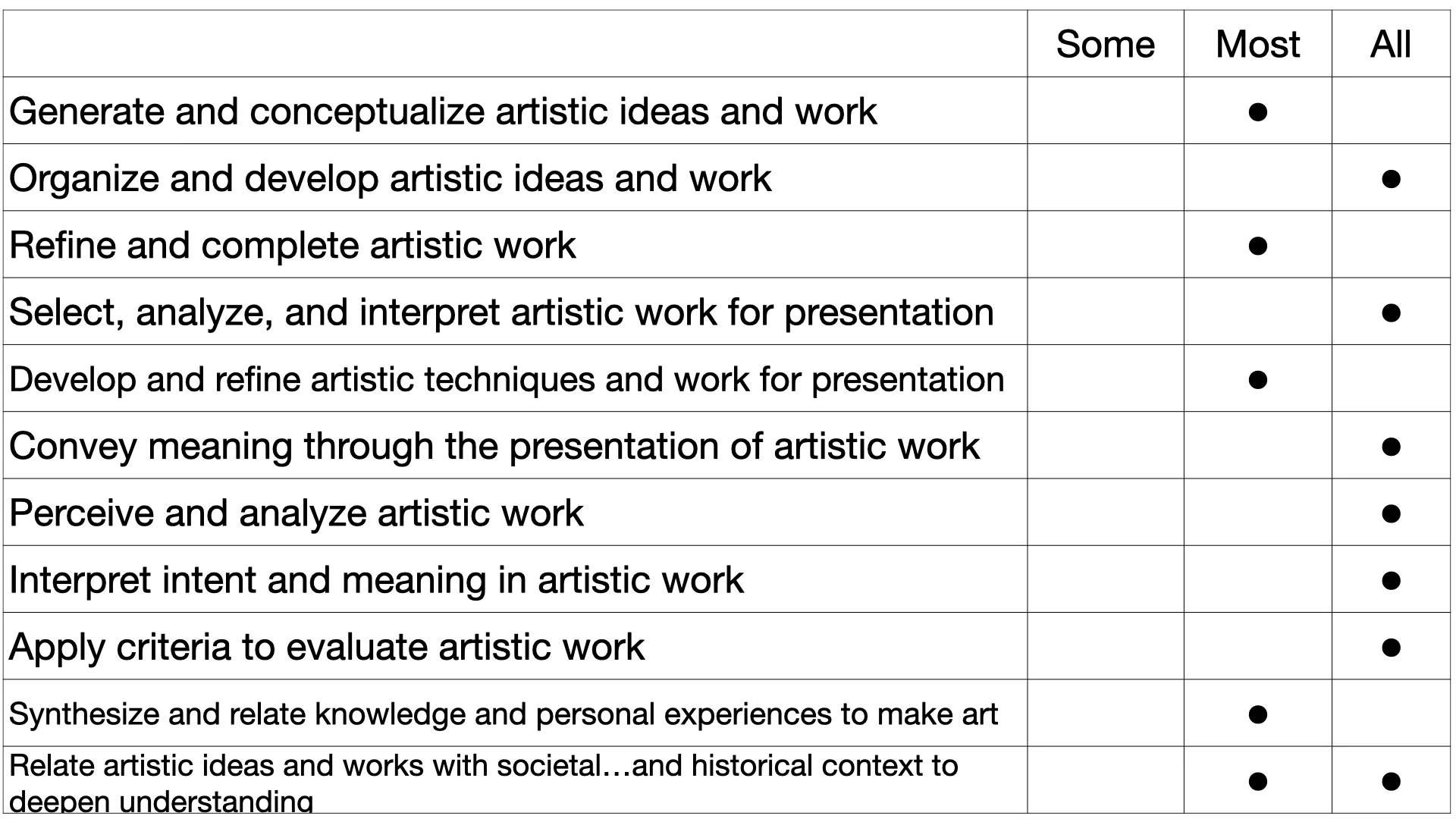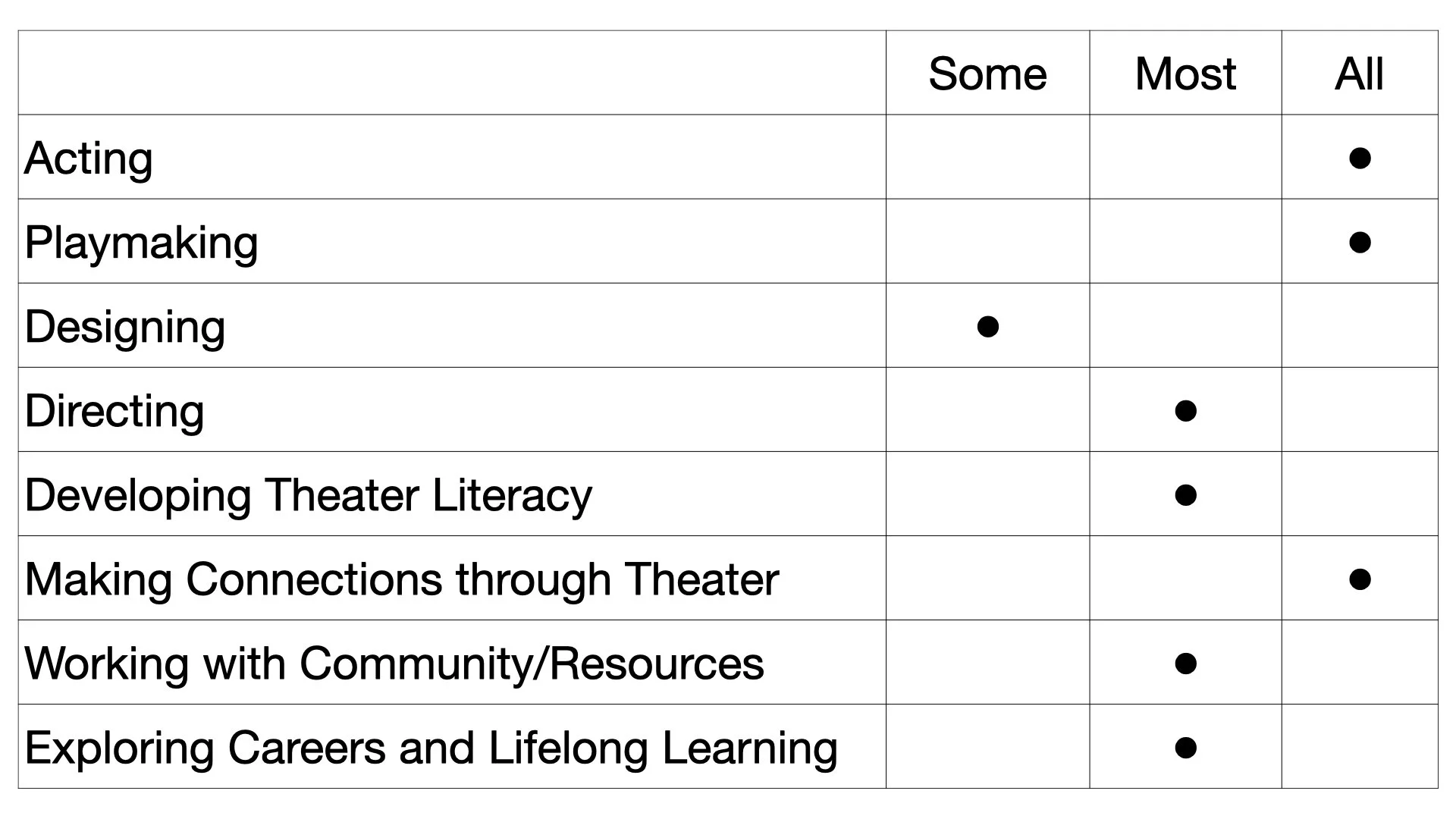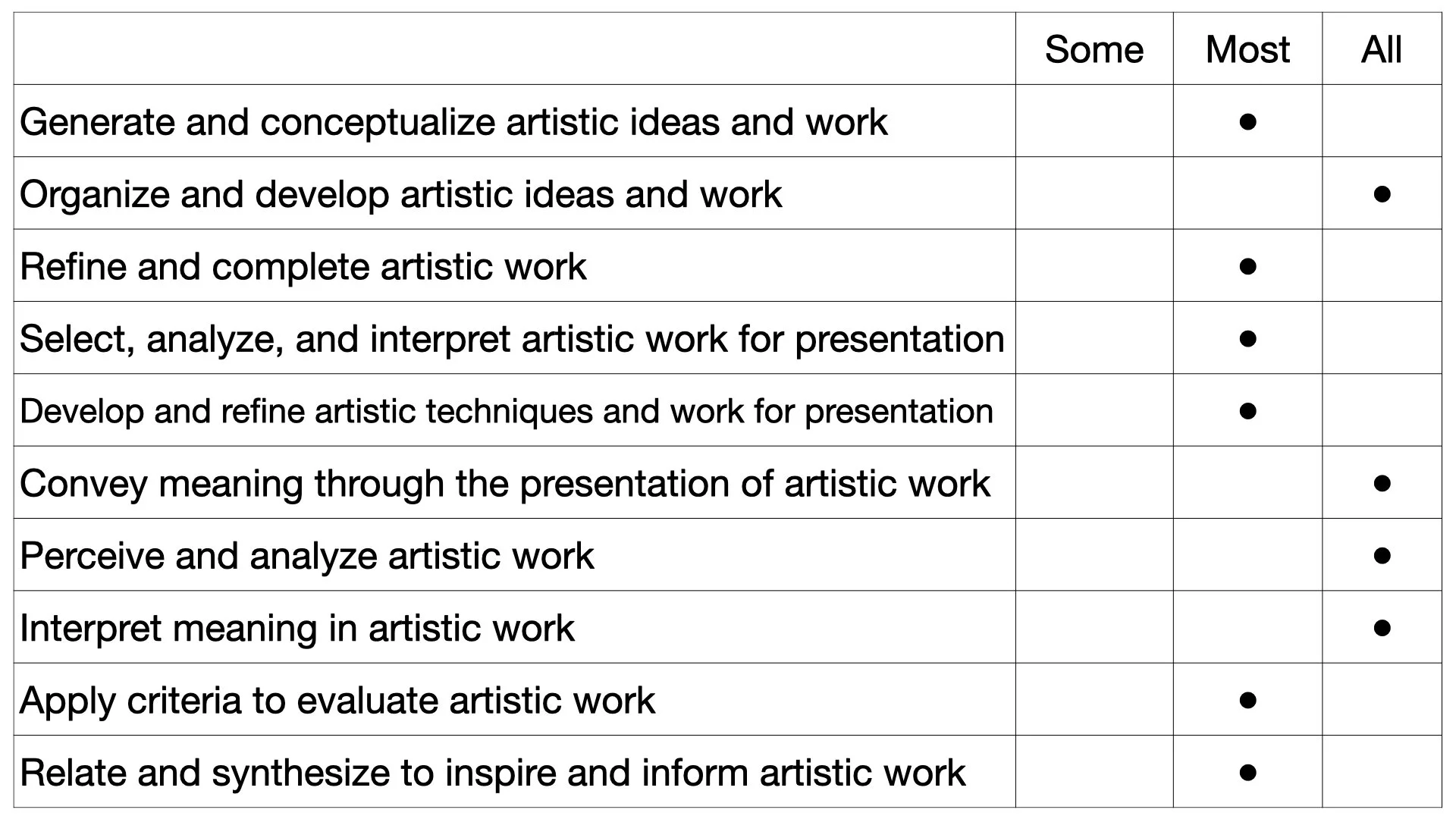Outcomes and standards in the U.S. and U.K.
That’s a check!
Stage It: Making Shakespeare Come Alive in Schools addresses many learning standards and outcomes around the world. Below are outcomes in the United Kingdom followed by U.S. standards alignment offered as representative samples. The below alignments were done in 2024 and they might have changed between when the analysis was conducted and now.
United Kingdom Outcomes
In the United Kingdom, the learning standards related to acting and drama for students aged 9–12 typically align with the National Curriculum for England (Key Stage 2 and lower Key Stage 3) or equivalent frameworks in Scotland, Wales, and Northern Ireland. Drama and acting are integrated primarily through English, Art and Design, and PSHE (Personal, Social, Health, and Economic education). Key outcomes include:
1. Communication and Language Skills (English)
Speaking and Listening:
Develop confidence in speaking and listening through performance, discussion, and role play.
Use dramatic techniques to explore and convey characters, situations, and emotions.
Reading and Interpretation:
Understand and interpret texts through dramatization, enhancing comprehension and empathy.
Analyze and perform scripts, exploring themes, characters, and narrative structure.
2. Collaboration and Teamwork
Work collaboratively to devise, rehearse, and perform dramatic pieces.
Develop negotiation and decision-making skills by contributing to group projects.
3. Creativity and Imagination (Art and Design)
Explore imaginative storytelling and creative self-expression through drama.
Use drama to reinterpret stories or historical events creatively.
4. Empathy and Social Skills (PSHE and Citizenship)
Explore moral and ethical dilemmas through role-play and dramatic scenarios.
Understand diverse perspectives and cultures by performing and discussing characters and narratives from various contexts.
5. Critical Thinking and Problem Solving
Analyze and evaluate performances to understand elements like mood, tension, and audience engagement.
Reflect on their work and others' work to improve skills and performances.
6. Cultural Understanding
Explore plays and dramatic traditions from different time periods and cultures, including Shakespeare and contemporary works.
Foster appreciation for theatre as an art form.
Alignment with Broader Educational Goals:
Drama also contributes to spiritual, moral, social, and cultural development (SMSC) by encouraging self-expression, creativity, and an appreciation of literature and the arts. Example frameworks by Nation:
England: National Curriculum for English (Key Stages 2 and 3) and Art and Design.
Scotland: Curriculum for Excellence – Expressive Arts and Literacy.
Wales: Curriculum for Wales 2022 – Expressive Arts and Languages, Literacy, and Communication.
Northern Ireland: The Northern Ireland Curriculum – Drama within Arts and Communication.
United States Standards Alignment
National Arts Standards in Theater Grades 5-8
NYC Blueprint for Teaching and Learning in Theater: PreK-12
New York State Learning Standards in the Arts Grades 5-8
U.S. Common Core Grades 5-8
1. Reading and Understanding Shakespeare's Text:
• CCSS.ELA-LITERACY.RL.5.1: Quote accurately from a text when explaining what the text says explicitly and when drawing inferences from the text.
• CCSS.ELA-LITERACY.RL.5.10: By the end of the year, read and comprehend literature, including stories, dramas, and poetry, at the high end of the grades 4-5 text complexity band independently and proficiently.
• CCSS.ELA-LITERACY.RL.6.1: Cite textual evidence to support analysis of what the text says explicitly as well as inferences drawn from the text.
• CCSS.ELA-LITERACY.RL.7.1: Cite several pieces of textual evidence to support analysis of what the text says explicitly as well as inferences drawn from the text.
• CCSS.ELA-LITERACY.RL.8.1: Cite the textual evidence that most strongly supports an analysis of what the text says explicitly as well as inferences drawn from the text.
2. Understanding Shakespeare's Language and Figurative Language:
• CCSS.ELA-LITERACY.L.5.4.A: Use context (e.g., cause/effect relationships and comparisons in text) as a clue to the meaning of a word or phrase.
• CCSS.ELA-LITERACY.L.5.5.A: Interpret figurative language, including similes and metaphors, in context.
• CCSS.ELA-LITERACY.RL.6.4: Determine the meaning of words and phrases as they are used in a text, including figurative and connotative meanings.
• CCSS.ELA-LITERACY.RL.7.4: Determine the meaning of words and phrases as they are used in a text, including figurative and connotative meanings.
• CCSS.ELA-LITERACY.RL.8.4: Determine the meaning of words and phrases as they are used in a text, including figurative and connotative meanings.
3. Analyzing Character Development:
• CCSS.ELA-LITERACY.RL.5.3: Compare and contrast two or more characters, settings, or events in a story or drama, drawing on specific details in the text.
• CCSS.ELA-LITERACY.RL.6.3: Describe how a particular story's or drama's plot unfolds in a series of episodes as well as how the characters respond or change as the plot moves toward a resolution.
• CCSS.ELA-LITERACY.RL.7.3: Analyze how particular elements of a story or drama interact (e.g., how setting shapes the characters or plot).
• CCSS.ELA-LITERACY.RL.8.3: Analyze how particular lines of dialogue or incidents in a story or drama propel the action, reveal aspects of a character, or provoke a decision.
4. Exploring Themes and Central Ideas:
• CCSS.ELA-LITERACY.RL.5.2: Determine a theme of a story, drama, or poem from details in the text, including how characters in a story or drama respond to challenges or how the speaker in a poem reflects upon a topic; summarize the text.
• CCSS.ELA-LITERACY.RL.6.2: Determine a theme or central idea of a text and how it is conveyed through particular details; provide a summary of the text distinct from personal opinions or judgments.
• CCSS.ELA-LITERACY.RL.7.2: Determine a theme or central idea of a text and analyze its development over the course of the text; provide an objective summary of the text.
• CCSS.ELA-LITERACY.RL.8.2: Determine a theme or central idea of a text and analyze its development over the course of the text, including its relationship to the characters, setting, and plot.
5. Speaking and Listening Skills:
• CCSS.ELA-LITERACY.SL.5.1: Engage effectively in a range of collaborative discussions (one-on-one, in groups, and teacher-led) with diverse partners on grade 5 topics and texts, building on others' ideas and expressing their own clearly.
• CCSS.ELA-LITERACY.SL.5.4: Report on a topic or text or present an opinion, sequencing ideas logically and using appropriate facts and relevant, descriptive details to support main ideas or themes; speak clearly at an understandable pace.
• CCSS.ELA-LITERACY.SL.6.1: Engage effectively in a range of collaborative discussions (one-on-one, in groups, and teacher-led) with diverse partners on grade 6 topics, texts, and issues, building on others' ideas and expressing their own clearly.
• CCSS.ELA-LITERACY.SL.7.1: Engage effectively in a range of collaborative discussions (one-on-one, in groups, and teacher-led) with diverse partners on grade 7 topics, texts, and issues, building on others' ideas and expressing their own clearly.
• CCSS.ELA-LITERACY.SL.8.1: Engage effectively in a range of collaborative discussions (one-on-one, in groups, and teacher-led) with diverse partners on grade 8 topics, texts, and issues, building on others' ideas and expressing their own clearly.
6. Integrating Visual and Performing Arts:
• CCSS.ELA-LITERACY.RI.5.7: Draw on information from multiple print or digital sources, demonstrating the ability to locate an answer to a question quickly or to solve a problem efficiently.
• CCSS.ELA-LITERACY.RI.6.7: Integrate information presented in different media or formats (e.g., visually, quantitatively) as well as in words to develop a coherent understanding of a topic or issue.
• CCSS.ELA-LITERACY.RI.7.7: Compare and contrast a text to an audio, video, or multimedia version of the text, analyzing each medium's portrayal of the subject.
• CCSS.ELA-LITERACY.RI.8.7: Evaluate the advantages and disadvantages of using different mediums (e.g., print or digital text, video, multimedia) to present a particular topic or idea.
7. Creative Writing and Script Adaptation (Optional):
• CCSS.ELA-LITERACY.W.5.3: Write narratives to develop real or imagined experiences or events using effective technique, descriptive details, and clear event sequences.
• CCSS.ELA-LITERACY.W.6.3: Write narratives to develop real or imagined experiences or events using effective technique, relevant descriptive details, and well-structured event sequences.
• CCSS.ELA-LITERACY.W.7.3: Write narratives to develop real or imagined experiences or events using effective technique, relevant descriptive details, and well-structured event sequences.
• CCSS.ELA-LITERACY.W.8.3: Write narratives to develop real or imagined experiences or events using effective technique, relevant descriptive details, and well-structured event sequences.
Please note that CHAT GPT assisted in the above analysis.





